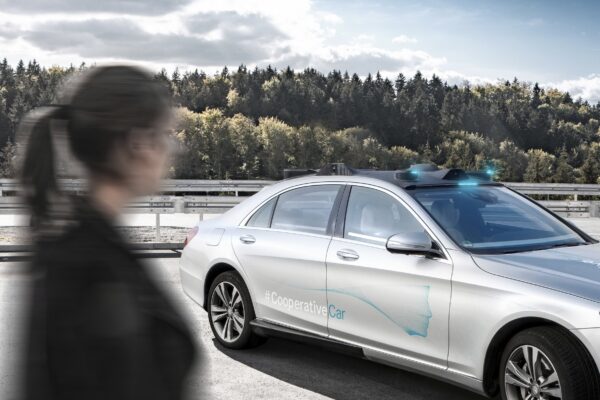
Daimler lets autonomous vehicles communicate with pedestrians
The Cooperative Vehicle based on a Mercedes-Benz S-class sedan is equipped with 360-degree light signalling. Turquoise lights on the roof indicate the autonomous driving mode and provide information about what happens next.
- Permanently illuminated light shows: The vehicle is in autonomous driving mode, regardless of whether it is driving or standing still.
- Slow flashing means that the vehicle is braking.
- Fast flashing announces: The vehicle is about to start driving.
In addition, alternative lighting concepts are also being tested with the vehicle: turquoise strip lights in the windscreen, radiator grille, headlamps, exterior mirrors and lower part of the windows mark the autonomous driving mode and thus inform pedestrians and other road users that the vehicle is travelling independently. Small rows of point lights on the roof indicate to other road users that they have been noticed. Only those pedestrians or cyclists whose movement path is related to that of the vehicle are flashed. The Cooperative Vehicle “feels” by measn of sensors and algorithms the natural eye contact that would occur between driver and pedestrian.
The vehicle equipped in this way also informs its environment when it starts operation while still standing at the curbside: The light bands around the vehicle generate a corresponding light signal. The exterior mirrors fold out, first the rear and then the front of the vehicle lift up. The developers were inspired to this movement because it reminds most humans of a large living creature that wakes up and stands up. This makes communication intuitive for most humans.
360-degree light signalling is particularly important for pedestrian information. This is the result of several studies carried out by Mercedes-Benz on its test site. The aim was to find out how pedestrians react to differently marked autonomous vehicles in different traffic situations. It became clear that light signalling has a decisive effect on the acceptance of autonomous vehicles and on pedestrians’ sense of safety.
The Daimler researchers discovered that people want light signalling, especially in situations in which passers-by were are used able to interact with a (human) driver. For example, people are used to looking for eye contact with the driver when they want to cross a road. If light signals are used to communicate that a vehicle is in autonomous driving mode, the pedestrian can feel safe even if the occupants obviously do not pay attention to what is happening on the road.
The majority of the participants in the studies preferred turquoise as the colour for signalling and were in favour of a 360-degree display. Daimler also contributes the results of its studies on the subject of “autonomous driving” to the engineering association SAE International, which among other things, develops standards in the field of mobility. Mercedes-Benz recommends the use of turquoise, a color not previously used in the automotive industry, to enable this kind of signalling.
In addition to the studies and the light signalling shown on the basis of the Cooperative Vehicle, Mercedes-Benz is also working on more far-reaching visions that should enable an “informed trust” between man and machine. Informed trust stands in contrast to blind trust. Towards this end, the entire outer shell of the vehicle becomes the communication medium for 360-degree communication. The classic body is transformed into a “digital exterior”.
Related articles:
Daimler sketches future transport platform for goods and people
JLR tests communication between autonomous vehicles and pedestrians
Exterior lighting becomes communication factor
 If you enjoyed this article, you will like the following ones: don't miss them by subscribing to :
eeNews on Google News
If you enjoyed this article, you will like the following ones: don't miss them by subscribing to :
eeNews on Google News




